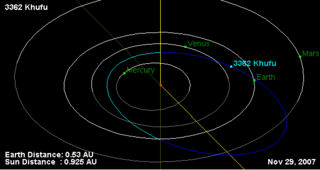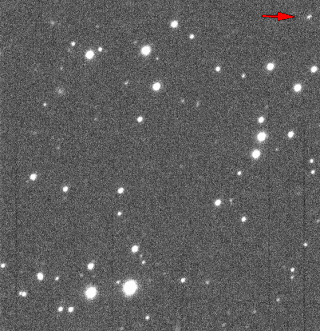
1862 Apollo is a stony asteroid, approximately 1.5 kilometers in diameter, classified as a near-Earth object (NEO). It was discovered by German astronomer Karl Reinmuth at Heidelberg Observatory on 24 April 1932, but lost and not recovered until 1973.
(179806) 2002 TD66 (also written 2002 TD66) is a sub-kilometer asteroid, classified as near-Earth object of the Apollo group. It was discovered on 5 October 2002, by the LINEAR project at Lincoln Laboratory's ETS in Socorro, New Mexico. It was announced on 7 October 2002 and appeared later that day on the JPL current risk page.

3362 Khufu is a near-Earth asteroid. It was discovered by R. Scott Dunbar and Maria A. Barucci at the Palomar Observatory in San Diego County, California, on 30 August 1984. Its provisional designation was 1984 QA. It is named after Khufu, an ancient Egyptian pharaoh. Khufu was the 4th Aten asteroid to be numbered.

2007 VK184 is a sub-kilometer asteroid, classified as a near-Earth object of the Apollo group, and estimated to be approximately 130 meters (430 ft) in diameter. It was listed on the Sentry Risk Table with a Torino Scale rating of 1 for a potential impactor in June 2048. It was removed from the Sentry Risk Table on 28 March 2014.
6063 Jason is an Apollo asteroid discovered on 27 May 1984, by Carolyn and Eugene Shoemaker at Palomar. Its highly eccentric orbit crosses the orbits of Mars, Earth, and Venus. From 1800 to 2200 it approached a planet within 30 Gm 69 times: Mercury 11, Venus 27, Earth 18, and Mars 13 times.
3361 Orpheus is an Apollo asteroid that was discovered on 24 April 1982 by Carlos Torres at Cerro El Roble Astronomical Station. Its eccentric orbit crosses that of Mars and Earth, and approaches Venus as well. From 1900 to 2100 it passes closer than 30 Gm to Venus 11, Earth 33, and Mars 14 times. It passed by Earth at a distance of about 0.03 AU in 1937, 1978, 1982, and 2021 and will again in 2025.
1994 WR12 is an asteroid and near-Earth object approximately 130 meters (430 feet) in diameter. As a member of the Aten group almost all of its orbit is closer to the Sun than Earth is. On 24 November 1994 it passed about 374100 km from the Moon. First imaged at Kitami Observatory on 26 November 1994, it was discovered two nights later by American astronomer Carolyn S. Shoemaker at Palomar Observatory on 28 November 1994. The asteroid then went unobserved from 1994 until it was recovered by Mauna Kea in March 2016. It was removed from the Sentry Risk Table on 2 April 2016.

(4953) 1990 MU is a large Earth-crossing asteroid (ECA) belonging to the Apollo group of near-Earth objects which also cross the orbits of Mars and Venus. At approximately 3 km in diameter, it is one of the largest known ECAs. It has been assigned a permanent number from the Minor Planet Center (4953) indicating that its orbit has been very well determined. With an observation arc of 45 years, the asteroid's trajectory and uncertainty regions are well known through to the year 2186.
(5604) 1992 FE is an Aten-type near-Earth minor planet. It was discovered by Robert H. McNaught at the Siding Spring Observatory in Canberra, Australia, on March 26, 1992. The asteroid is 550 meters (1,800 ft) in diameter.
343158 Marsyas (prov. designated2009 HC82) is an asteroid on a retrograde orbit, classified as a large near-Earth object of the Apollo group. It may be an extinct comet or damocloid asteroid. The asteroid was discovered on 29 April 2009, by astronomers with the Catalina Sky Survey at the Catalina Station near Tucson, Arizona, in the United States. Approximately 2 kilometers (1.2 miles) in diameter, it makes many close approaches to Earth, Venus, and Mars at a very high relative velocity. It was named after the satyr Marsyas from Greek mythology.

(276033) 2002 AJ129, provisional designation 2002 AJ129, is a Mercury-crossing asteroid. It has the ninth-smallest perihelion of all numbered asteroids, after asteroids such as 2000 BD19, 2004 UL, and 2008 XM. It makes close approaches to all of the inner planets and asteroid 4 Vesta. The asteroid is estimated to be between 0.5–1.2 kilometers (0.3–0.7 mi) across. In January 2018 there was much media hype about this asteroid being classified as a potentially hazardous asteroid, although there is no known threat of an impact for hundreds if not thousands of years. The media has compared the size of the asteroid to the Burj Khalifa in Dubai.
(7888) 1993 UC is a near-Earth minor planet in the Apollo group. It was discovered by Robert H. McNaught at the Siding Spring Observatory in Coonabarabran, New South Wales, Australia, on 20 October 1993. The asteroid has an observation arc of 23 years and has a well determined orbit. Its estimated size is 2.3 to 5.2 km.
(612358) 2002 JE9 (also written 2002 JE9) is an Apollo near-Earth asteroid and potentially hazardous object. It has a well determined orbit with an observation arc of 10 years and an Uncertainty Parameter of 1. It was removed from the Sentry Risk Table on 10 May 2002. 2002 JE9 was discovered on 6 May 2002 by the Lincoln Near-Earth Asteroid Research (LINEAR) project using a 1.0-metre (39 in) Reflecting telescope; at the time of discovery, the asteroid possessed an apparent magnitude of 19.1.
(101869) 1999 MM, provisional designation 1999 MM is a sub-kilometer asteroid on an eccentric orbit, classified as a near-Earth object and potentially hazardous asteroid of the Apollo group. It was discovered on 20 June 1999, by the Lowell Observatory Near-Earth-Object Search (LONEOS) at its U.S. Anderson Mesa Station in Flagstaff, Arizona. The first observation was made by Catalina Sky Survey just 8 days before its official discovery.

(511002) 2013 MZ5, provisional designation 2013 MZ5, is a sub-kilometer asteroid, classified as a near-Earth object of the Amor group, estimated to measure approximately 300 meters (1,000 feet) in diameter. It was discovered on 18 June 2013, by astronomers with the Pan-STARRS survey at Haleakala Observatory on the island of Maui, Hawaii, in the United States. It was the 10,000th near-Earth object ever discovered.

2005 HC4 is the asteroid with the smallest known perihelion of any known object orbiting the Sun (except sungrazing comets). Its extreme orbital eccentricity brings it to within 0.071 AU of the Sun (23% of Mercury's perihelion) and takes it as far as 3.562 AU from the Sun (well beyond the orbit of Mars). Due to its very small perihelion and comparably large aphelion, 2005 HC4 achieves the fastest speed of any known asteroid bound to the Solar System with a velocity of 157 km/s (565,000 km/h; 351,000 mi/h) at perihelion (there are comets, however, which obtain much higher speeds).
(456938) 2007 YV56, provisional designation 2007 YV56, is a sub-kilometer asteroid on an eccentric orbit, classified as a near-Earth object and potentially hazardous asteroid of the Apollo group, approximately 190–360 meters (620–1,200 ft) in diameter. It was discovered on 31 December 2007, by astronomers of the Catalina Sky Survey conducted at the Catalina Station in Arizona, United States.
(415713) 1998 XX2 is a sub-kilometer asteroid, classified as a near-Earth object and potentially hazardous asteroid of the Aten group. It was discovered 8 December 1998, by the Lincoln Near-Earth Asteroid Research at Lincoln Laboratory's Experimental Test Site, and was found to have frequent approaches to the Earth, Venus, and Mercury.

2018 CC is a micro-asteroid, classified as a near-Earth object of the Apollo group, approximately 20 meters (70 ft) in diameter. Its official first observation was made by the Catalina Sky Survey at Mount Lemmon Observatory, Arizona, United States, on 4 February 2018. Two days later, the asteroid crossed the orbit of the Moon and made a very close approach to Earth.

2020 LD is an Apollo near-Earth asteroid roughly 140 meters in diameter. It was discovered on 7 June 2020 when the asteroid was about 0.03 AU from Earth and had a solar elongation of 154 degrees. The glare of the Sun had masked the approach of the asteroid since November 2019. The asteroid passed closest approach to Earth on 5 June 2020 at a distance of 0.002 AU. The close approach distance is now known with an accuracy of roughly ± 1000 km. This is the largest asteroid to pass closer than the Moon this year and possibly the largest since (308635) 2005 YU55 in November 2011. The asteroid makes close approaches to Mercury, Venus, Earth, and Mars. It will be brighter than apparent magnitude 24 until 18 July 2020.









